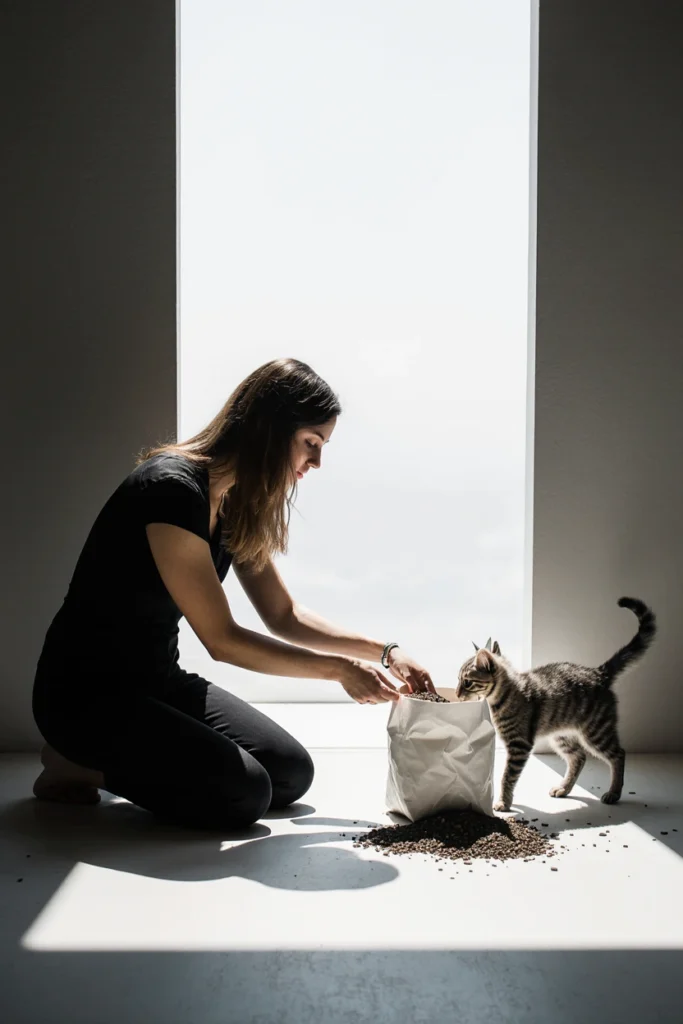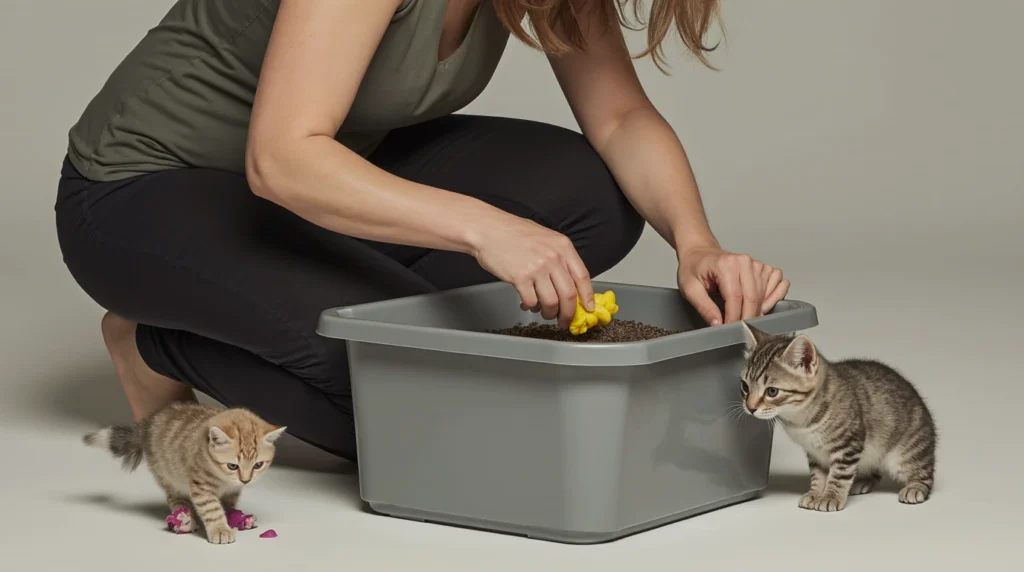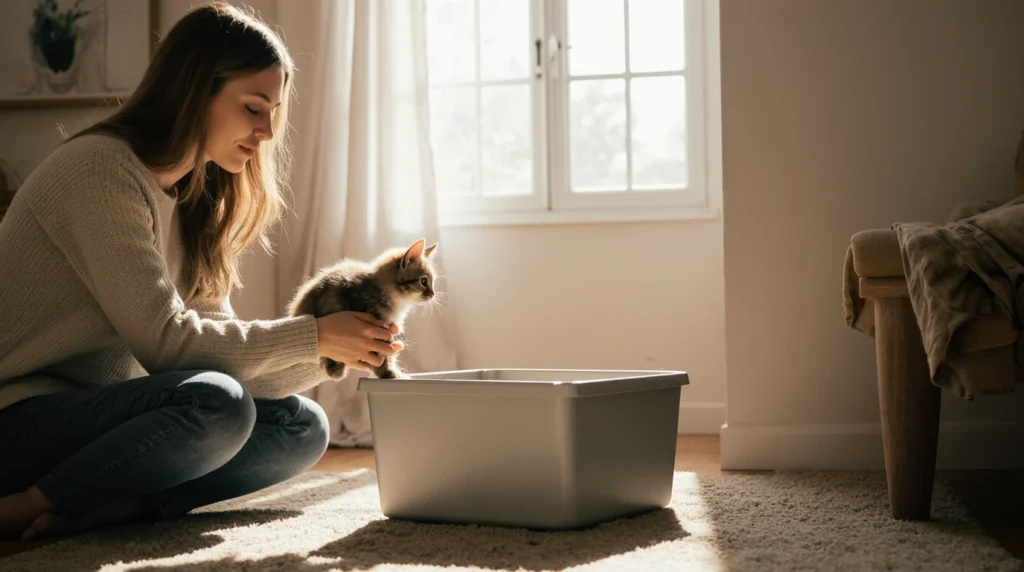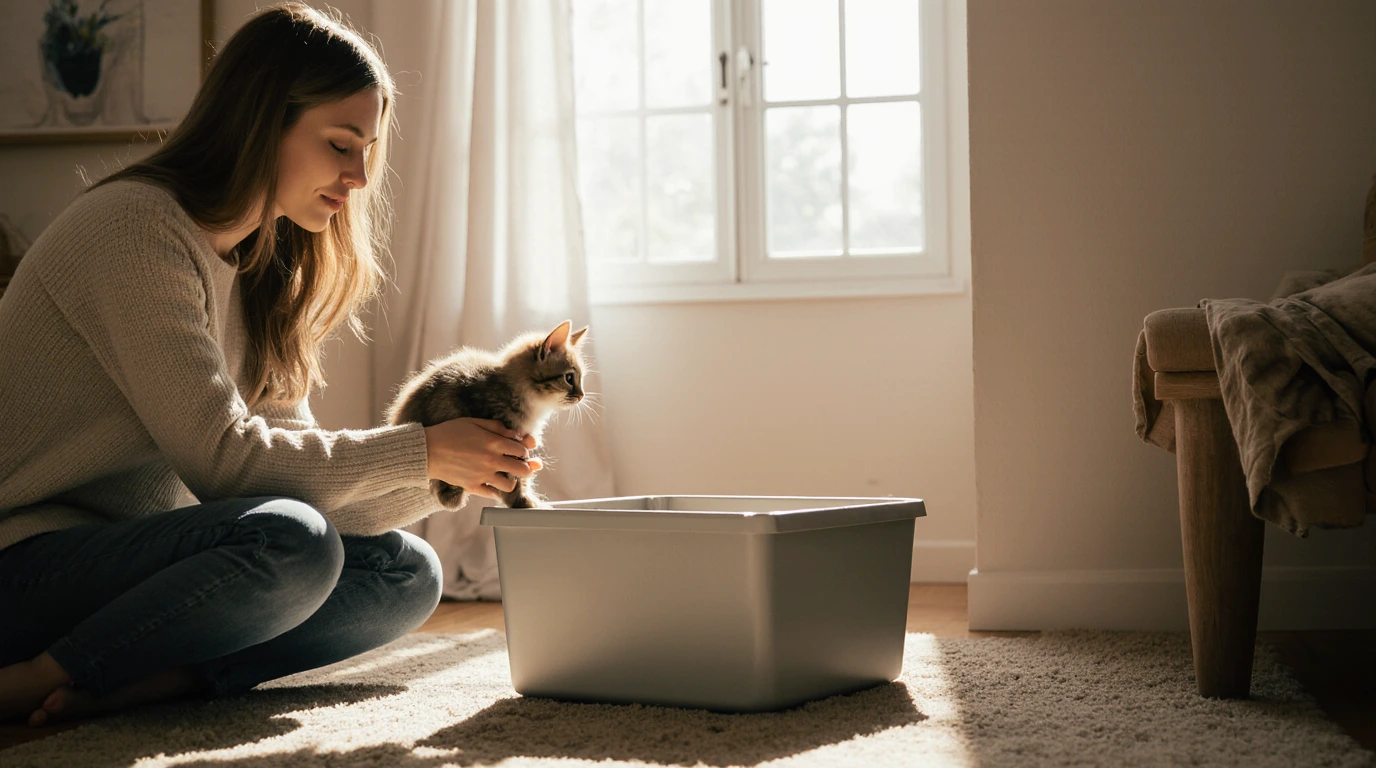kitty litter clumping
Let’s be real—cleaning a litter box isn’t exactly the highlight of your day. But what if a small tweak could make it way less gross, and a lot more manageable? Enter clumping kitty litter—the unsung hero of every cat parent’s routine.
In short, clumping litter binds your cat’s waste into firm, scoopable chunks, making cleanup faster, neater, and (dare we say?) borderline satisfying. Whether you’re a new cat owner wondering what type of litter to buy, or you’re tired of dealing with sticky sludge and lingering odors, this guide will walk you through everything you need to know—from how clumping works to which types actually live up to the hype.
By the end, you’ll not only understand why clumping litter is such a game-changer—you’ll know how to choose the right one for your cat, your budget, and your peace of mind.
Table of Contents
Benefits of kitty litter clumping

Clumping litter didn’t just catch on because it sounded fancy—it solves very real, very messy problems. If you’ve ever wrestled with soggy, stinky litter that disintegrates on contact or leaves a residue of regret in your scoop, you’ll get why clumping is the gold standard for so many cat owners.
1. Easier Cleanup, Less Hassle
The main appeal? You can scoop and go. Clumping litter forms solid, tight balls around moisture—usually urine—so you can clean only the soiled portions without dumping the entire box. That means less waste, fewer full box changes, and honestly, a far less gag-inducing experience.
2. Odor Control That Actually Works
Clumping litter isn’t just about texture—it’s about smell. By trapping moisture quickly, it prevents odor from escaping into the room. Many clumping formulas also come reinforced with odor-neutralizing agents like baking soda or charcoal, making them ideal for small spaces or multi-cat homes.
3. Long-Term Cost Efficiency
Here’s a counterintuitive truth: clumping litter often costs more up front, but saves you money in the long run. Since you’re only removing clumps and not the entire tray of litter, a single box can last longer than non-clumping alternatives. That’s fewer purchases—and fewer lugging-heavy-bags-home days.
4. Better Fit for Automated Litter Boxes
Got a self-cleaning box? Most of them rely on the clumping process to detect and remove waste automatically. Without proper clumps, these gadgets become nothing more than noisy plastic ornaments. A strong clumping formula ensures your robotic assistant does its job.
FAQ — Is clumping litter safe for all cats?
Q: Is clumping litter safe for kittens or cats with respiratory sensitivities?
A: Not always. Many clumping litters—especially clay-based ones—create dust that can irritate sensitive lungs or eyes. For kittens, who might ingest the litter out of curiosity, clumping can pose a risk of intestinal blockage. In those cases, start with a non-clumping or plant-based low-dust formula until they’re older or more accustomed.
Drawbacks to Be Aware Of
Clumping kitty litter is often pitched as the ultimate solution—but let’s not pretend it’s perfect. Like anything, it comes with trade-offs. Depending on your cat’s health, your living space, or even your flooring, certain issues might creep up. Here’s what to look out for before jumping all in.
1. Dust and Respiratory Irritation
Even the best clumping litters—especially those made with sodium bentonite clay—can kick up fine dust during pouring or scooping. For humans with allergies or asthma, or cats with respiratory sensitivities, that dust can be a problem. Low-dust or dust-free claims aren’t always 100% accurate either—so be ready to experiment.
2. Litter Tracking All Over the House
Clumping litters often have finer grains, which tend to stick to your cat’s paws. Next thing you know, you’re stepping on granules in your hallway, your bed, or—worst case—your freshly mopped kitchen floor. Some solutions include heavier pellet-based clumping litters or textured mats outside the box, but tracking remains a common gripe.
3. Not Ideal for Young Kittens
Here’s where it gets serious: clumping litter isn’t recommended for kittens under 4 months old. Curious babies sometimes ingest the litter, and the clumping agents can expand in their digestive system—potentially leading to dangerous blockages. Until they’re older, a non-clumping, digestible-safe formula is your best bet.
4. Environmental Impact and Disposal Limits
Clay-based clumping litters aren’t biodegradable. They’re mined from the earth and end up in landfills. If eco-friendliness is important to you, this might feel like a deal-breaker. And unlike some plant-based litters, clay versions aren’t flushable, so they add to your trash load.
FAQ — Can clumping litter clog plumbing if flushed?
Q: Can I flush clumping litter down the toilet if it’s labeled “flushable”?
A: Proceed with caution. While some plant-based clumping litters claim to be flushable, flushing any type of litter—especially in older plumbing systems—can cause blockages. And if you’re on a septic system, forget it. Always check both the packaging and local regulations before trying.
Types of Clumping Litter – kitty litter clumping
Not all clumping litters are created equal. While the concept is the same—liquid waste binds into solid clumps—the materials and performance vary wildly. Some prioritize eco-friendliness, others focus on strength, scent control, or minimizing dust. Let’s walk through the main types and what makes each one tick.
1. Clay-Based Clumping (Bentonite Clay)
This is the OG clumping litter. It works fast, clumps hard, and typically offers the strongest odor control. Sodium bentonite clay swells on contact with moisture, forming tight clumps that are easy to scoop.
- Pros: Strongest clumping, good for multi-cat homes, widely available.
- Cons: Not biodegradable, can be dusty, heavier to carry.
2. Plant-Based Clumping (Corn, Wheat, Walnut, Wood)
If you’re looking for a greener alternative, these are your go-to options. They use natural materials that bind moisture into soft to medium clumps, and many are compostable or flushable.
- Corn: Lightweight and flushable, but some users report occasional mold issues.
- Wheat: Subtle scent, decent clumping, good for sensitive noses.
- Walnut Shell: Darker in color, solid clumping, naturally deodorizing.
- Wood (Pine, etc.): Low dust, naturally absorbent, but clumps may break apart more easily.
- Pros: Biodegradable, usually low dust, lighter.
- Cons: Clumping may be weaker than clay, more expensive, variable smell profiles.
3. Silica Gel-Based (Crystal) Litter with Clumping
Less common but growing in popularity, these use silica crystals with added clumping agents. They absorb moisture and control odor effectively, but their clumps can be more fragile.
- Pros: Excellent odor control, ultra-low dust, long-lasting.
- Cons: Pricey, some cats dislike the texture, weaker clumps.
FAQ — What’s the best clumping litter for scent-sensitive cats?
Q: Which type of clumping litter is best for cats that hate strong smells?
A: Plant-based litters—like unscented corn or wheat options—tend to be gentler on feline noses. They control odor naturally without the overpowering perfumes found in many clay brands. Always go fragrance-free if your cat shows signs of scent aversion (e.g., avoiding the box, sneezing).

How to Choose the Best Clumping Litter
Let’s be honest—standing in the pet aisle, staring at 20 different bags of kitty litter, all shouting about being “ultra,” “fresh,” or “dust-free,” can feel like decision overload. So instead of chasing marketing jargon, here’s a grounded, cat-parent-approved checklist to help you make the smartest pick.
1. Clumping Strength and Speed
The best litters form tight clumps fast. If it takes too long, liquid seeps, spreads, and turns into sludge. Look for litters that promise hard clumps in seconds—not minutes. Bonus if they don’t crumble when scooped.
- Red Flag: If reviews mention “clumps fall apart” or “sticks to scoop,” skip it.
2. Odor Control Without the Overkill
Some litters mask odor with artificial scents so strong, they’re more offensive than the smell they’re trying to cover. If you or your cat is scent-sensitive, go for unscented formulas that use natural odor neutralizers like:
- Baking soda
- Activated charcoal
- Probiotics
Scented options can work in ventilated areas or for multi-cat homes—but only if your cat doesn’t mind.
3. Low Dust = Healthier Living
Even if the label says “99% dust-free,” read the reviews. Cats with asthma, humans with allergies, or even just a sunny window nearby (where dust shows up like a crime scene) will thank you for choosing a truly low-dust formula.
- Plant-based litters usually win here. Crystal litters are second. Clay is hit or miss.
4. Tracking & Granule Size
If you hate seeing litter pebbles scattered like breadcrumbs across the floor, go for larger, heavier granules or pellet-style clumping litter. Also consider:
- High-sided boxes
- Litter mats outside the box
- Avoiding ultra-fine sand-like textures
5. Eco-Friendliness & Disposal Method
Clay-based litters are mined, non-renewable, and non-biodegradable. If sustainability matters to you, look at:
- Corn or wheat (renewable and compostable)
- Wood or walnut (biodegradable and odor-neutralizing)
- Flushable options—but only if your plumbing can handle it
FAQ — What’s the most important factor when choosing clumping litter?
Q: If I could only focus on one thing, what should it be?
A: Clumping strength. A litter that doesn’t clump well turns your box into a swamp—no matter how great it smells or how eco-friendly it is. Strong, fast clumps make every other feature more effective.
Common Myths & Misconceptions About Clumping Litter
With all the buzz around clumping kitty litter—some glowing, some skeptical—it’s easy to get caught in the fog of misinformation. Let’s clear the air by busting some of the most persistent myths cat owners fall for when choosing clumping litter.
Myth 1: Clumping Litter Is Toxic to Cats
This is one of the internet’s favorite fears—but the truth is more nuanced. Most reputable clumping litters are non-toxic and safe for adult cats when used as directed. The concern typically stems from kittens ingesting it, or extreme cases where cats inhale too much dust. For healthy adult cats, it’s generally very safe. The key? Supervise kittens and choose low-dust, unscented options for sensitive pets.
Myth 2: All Clumping Litter Is Dusty
Not anymore. While older clay formulas were practically fog machines, newer low-dust or dust-free options exist—especially among plant-based and silica alternatives. Just don’t take “99% dust-free” at face value. Check reviews and test small bags before committing.
Myth 3: You Can’t Switch Litter Types
This one’s half true. Cats are creatures of habit, but that doesn’t mean they’re stuck with one brand forever. The trick is gradual transitioning: mix in the new litter a bit at a time over 5–7 days. Sudden changes can trigger litter box avoidance—but done slowly, most cats adapt just fine.
Myth 4: Clumping Litter Is Bad for the Environment
Yes, some is. Clay-based clumping litter is strip-mined and non-biodegradable. But eco-conscious cat parents now have options—like corn, wheat, or wood-based clumping litters—that break down naturally and even support composting in some regions. The myth holds up for old-school clay… but not the whole category.
FAQ — Can I switch from non-clumping to clumping litter without upsetting my cat?
Q: Will switching to clumping litter stress my cat out or cause accidents?
A: Possibly, but it depends on how you do it. Cats dislike abrupt changes to their bathroom routine. To avoid stress, gradually mix clumping litter into the old litter over a week. Watch for signs of aversion like peeing outside the box, and backtrack if needed. Most cats adjust smoothly if the transition feels familiar.
Top Brands & Comparisons
Choosing the “best” clumping litter isn’t just about what works—it’s about what works for you. One cat parent might swear by odor-locking clay; another can’t live without biodegradable corn. Below, we break down popular brands by material type, performance, and ideal use case—so you don’t have to rely on label hype alone.
Clay-Based Champions (Bentonite)
1. Dr. Elsey’s Ultra
- Best For: Multi-cat households, heavy odor control
- Why It Works: Forms rock-hard clumps, low tracking, unscented
- Watch Out For: Heavy bag, some users report moderate dust
2. Arm & Hammer Clump & Seal
- Best For: Odor-sensitive homes
- Why It Works: Baking soda-infused, strong scent seal, tight clumping
- Watch Out For: Scent may be too intense for some cats
3. Tidy Cats Clumping (by Purina)
- Best For: Budget-conscious cat owners
- Why It Works: Readily available, solid clumps, mild scent
- Watch Out For: Higher dust levels in some variants
Plant-Based Alternatives
4. World’s Best Cat Litter (Corn-Based)
- Best For: Eco-conscious cat parents
- Why It Works: Flushable, lightweight, minimal dust
- Watch Out For: Softer clumps that may crumble during scooping
5. Okocat (Wood-Based)
- Best For: Low-tracking and allergy-sensitive households
- Why It Works: Biodegradable, low scent, excellent absorption
- Watch Out For: Slightly more expensive, may require frequent stirring
6. sWheat Scoop (Wheat-Based)
- Best For: Natural product lovers
- Why It Works: Enzyme-based odor control, compostable
- Watch Out For: Lighter clumps, may attract pests if not stored properly
Crystal-Based Options
7. Fresh Step Crystals
- Best For: Single-cat homes, ultra-low maintenance
- Why It Works: Absorbs moisture without much smell, nearly dust-free
- Watch Out For: Doesn’t clump as firmly; not great for scooping lovers
FAQ — Which litter brand is best for multi-cat households?
Q: What’s the most effective clumping litter if I have two or more cats?
A: Dr. Elsey’s Ultra or Arm & Hammer Clump & Seal are both strong contenders. They’re known for tight clumping, powerful odor control, and holding up under frequent use. For an eco-friendly angle, World’s Best Cat Litter (Multi-Cat formula) is a solid alternative—just be prepared for lighter clumps.
Usage & Maintenance Tips
You’ve picked the clumping litter. Great. Now comes the part that separates the confident cat parents from the ones Googling “why does my house smell like regret.” The truth is, even the best litter fails if used wrong. Here’s how to keep things fresh, functional, and frustration-free.
1. Scoop Daily—Yes, Every Day
Clumping litter is only as good as your follow-through. Scooping daily prevents odor buildup and bacterial growth, and it keeps your cat from rejecting the box. Trust us: skipping a day or two might not seem like a big deal… until your cat decides the rug is a better option.
2. Do a Full Litter Change Every 2–4 Weeks
Even if you’re scooping daily, gunk and ammonia build up in the base. Every few weeks (or weekly for smaller boxes), dump the entire contents, wash the box with mild soap, and refill with fresh litter. This reset prevents odor layering and keeps clumping performance sharp.
3. Use the Right Depth
Most clumping litters work best at around 3–4 inches deep. Too shallow and waste hits the bottom—leading to gross stickage. Too deep and it becomes a digging pit that wastes litter. Stick to the middle ground and adjust based on your cat’s habits.
4. Combat Tracking with Smart Setups
Clumping litter—especially fine-grain types—loves to hitch a ride on paws. To reduce the scatter:
- Place a textured mat outside the box
- Consider a top-entry litter box
- Try larger pellet formulas for less cling
5. Store Litter Properly
Keep your litter in a sealed, dry container. For plant-based types, moisture can lead to mold. For clay-based litters, open bags can absorb odors before you even pour them. A sealed tub keeps it clean, clump-ready, and fresh-smelling.
FAQ — How often should I completely replace clumping litter?
Q: If I’m scooping daily, do I still need to replace all the litter?
A: Yes, but less often. While daily scooping keeps the surface clean, urine particles and ammonia can accumulate in the base over time. A full change every 2–4 weeks (depending on litter type and cat use) is essential for hygiene and odor control.


